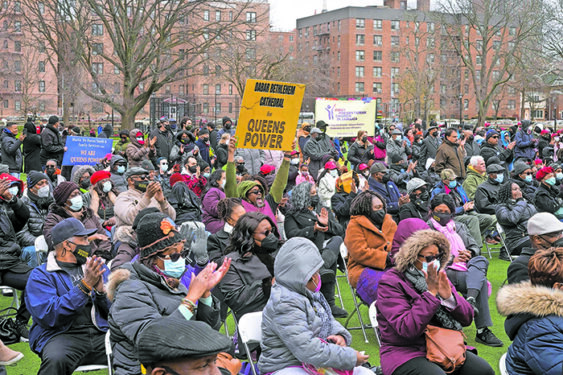
QUEENS VILLAGE — The fight for affordable housing at a Queens Village site slated for major redevelopment by New York state has the support of local Catholic priests who are working with a nonprofit organization seeking to get 3,000 apartments built there.
Father Patrick Longalong, pastor of Our Lady of Lourdes Church in Queens Village; Father Daniel Kingsley, pastor of St. Clare Church in Rosedale; and Father Hugh Burns, OP, administrator of St. Teresa of Avila-St. Anthony of Padua Parish in Ozone Park, are all working with Queens Power, the organization leading the drive for affordable housing at the state-owned Creedmoor Psychiatric Center campus in Queens Village.
On Sunday, June 11, Queens Power held a rally in a park across from the Creedmoor campus attended by hundreds of people from across the borough to call on the state to ensure that any plan to redevelop the site includes affordable housing.
Queens Power’s goal is to get 3,000 housing units erected at Creedmoor — a combination of small private homes and apartment buildings, said Robert English, the organization’s lead organizer. “We would like to see something similar to what you see in the Gateway Mall at Spring Creek,” he said, referring to the Spring Creek Towers (also known as Starrett City), a housing development in East New York.
The New York State Empire Development Corporation (EDC) is the lead agency in planning to redevelop a 55-acre section of the sprawling campus, and as a first step is seeking community input. In February, EDC began hosting in-person and virtual workshops to gather input.
The next step in the process will be the creation of the Creedmoor Community Master Plan, the document that EDC will use as a framework for the redevelopment.
Creedmoor began housing mentally ill patients in 1912 and at its height in the 1950s housed 7,000 people. Starting in the 1960s, the state de-institutionalized people with mental health challenges and Creedmoor began to empty out. Currently, it houses only small inpatient and outpatient treatment centers.
“We want to make sure that whatever is done there includes housing. It’s badly needed,” said Father Longalong, a member of Queens Power’s executive team.
Father Burns, who called housing “the number one issue” facing New York City, said residents are finding it increasingly difficult to afford to live here. “Are we going to be a place only for billionaires to build luxury condos or are we going to build housing that people can afford?” he asked.
“What we are hoping to do is to hold Governor [Kathy] Hochul’s feet to the fire,” Father Kingsley said. “We’ve seen many politicians who have spoken about the need for government to be responsive to the concerns of the working poor. And what better way to do it?”
Father Kingsley recalled a recent encounter with a St. Clare’s parishioner who approached him after Mass and asked him for help finding an apartment.
According to the website RentCafe, the average apartment size in Queens is 710 square feet. The monthly rent depends on the neighborhood. In Hunter’s Point the average is $3,855. Long Island City residents pay an average of $3,788. Renters pay an average of $2,066 in Downtown Flushing, while people living in Jamaica pay an average of $2,041.
For people looking to buy a home in Ozone Park, the price tag is upwards of $700,000, Father Burns said. “That’s out of reach for a lot of people,” he added.
The Creedmoor redevelopment provides a golden opportunity to address the housing crisis, Father Longalong said. “We need affordable housing wherever we can build it. This is a big piece of land, so that presents us with a chance,” he explained.
The involvement of the clergy in Queens Power is significant, English said. “The Diocese of Brooklyn has always been very supportive of our efforts to get affordable housing in the form of home ownership built. Their voice is important,” he added. Rosemary Lopez, executive director of AIDS Center of Queens County and a member of Queens Power’s executive team, said the June 11 rally was a success because it helped the organization get its point across.
Lopez added that while new housing is being built in some neighborhoods, much of it is being constructed by private developers and is unaffordable. “It is driving people out of the borough,” she said.
AIDS Center of Queens County, which serves 10,000 clients at five sites, joined Queens Power precisely because of the housing issue, Lopez explained. Queens Power, which was formed in 2019, is composed of 48 groups including churches, nonprofits, and unions.
“We’ve been advocating on this issue for years. It’s good to put ourselves together with other groups so that we could all work together,” Lopez said.
Queens Power’s portfolio covers the gamut from the push for affordable housing to the effort to get the city to install traffic lights at dangerous intersections.“No issue is too big for us, or too small,” Father Longalong said.
For example, Queens Power organized a walking tour of Ozone Park for city Transportation Commissioner Ydanis Rodriguez last year so he could see traffic safety concerns up close. “The next day, the city was putting up stop signs,” Father Burns recalled.
Queens Power works on building relationships with city officials so they then can request action, the official can put a face together with a name, Father Longalong said.
